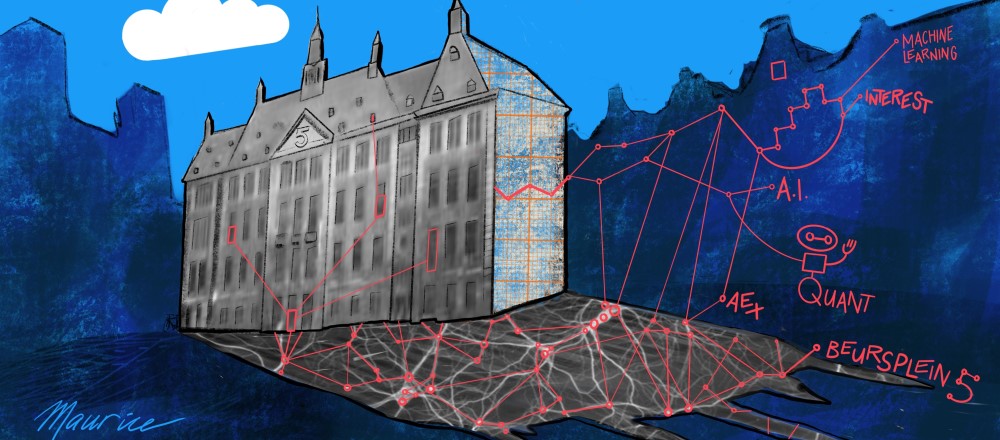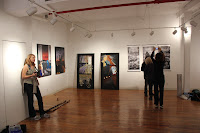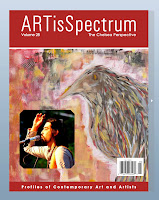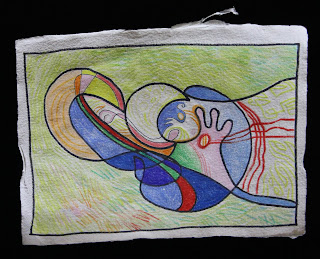Art, its concepts and reflections are a great way to get a clearer view on oneself and on our society. The way we were raised and the role models we grew up with make us for a large part a product of our society. And this influences our observations, behaviours and thoughts. An artist in his/her art works on many occasions peels the 'union' of the inner self, going deeper and deeper. Removing these layers of culture* bring us deeper to ourselves; our inner character, our deeper values, our structural challenges, our blue print and our dysfunctions. This process (among many other things) brings us the ability to better observe the outside world and our direct environment, more purely and independently.

Recently I have observed several trends and shared thoughts with many people and read some articles about trends and expectations for the coming decades. It is also interesting that these observations show a correlation in completely different areas; in my life and work as an artist and as a successful manager in the financial industry. I would describe the observation as a '
designification' of our work, art and life. Please allow me to provide some background to this.
1. Observations of behaviour
A. Observations from Art
In the art world we see that - even more now we are in a financial crisis - galleries focus on mainstream art; art that sells. When an artist is successful with one style, the gallery owner or agent will stimulate the artist to focus on that area, in a way blocking the exploration of new ideas, concepts and styles by the artist; blocking his journey into himself.
I observe artist making artworks that are more easily accessible to buyers, varying for years and years n the same theme....as it has proven to be successful or variations on old themes...

Another observation is that the art world has become more 'popular' and accessible. It is much easier than years before to obtain materials, do a workshop, organise promotion and declare yourself as an artist. Where initially the primary drive for artists seems to have been a certain 'inner drive to express' and a desire to bridge the gap between now and eternity, I observe some new more prominent motivations to get involved in art. More and more it seems it is a form of self-realisation, and a way ( and sometimes a desire) to be noticed. Where the traditional artist is mainly introspective and would need some stimulation to present his/her art; now artists are publishing and exposing in the hope to be 'discovered soon' by a renowned gallery or collector. Recently for example an artist approached me:
"I am now already 2 years active as an artist; and still I have not been discovered by a gallery". Or another artist "how come you have been discovered by this New York gallery; what are the steps to be discovered?".
Also I see frequently art works exhibited that show a struggle with the actual materials; and then
clearly 'unskilled' art works being offered for 7.000 USD...Of course we are all following our path towards discovering our style and adopting new skills; and I am continuously following these paths too. At the same time the basic starting point of creating a successful art work is skill. As such the primary focus of an artist should be to explore new routes and continue exploring skills; getting (mentor) feedback and keep improving the expression and depth of the art works. Focus should not be to exhibit and sell before basic skills have been obtained. I read in an article recently that
an average artist spends around 30.000 hours on art/painting before being discovered...
I would say this difference between artists being more focused on "design" than "artistic" elements is not new. In this light for example we see the more 'artistic' approach in
Picasso; when reaching perfection in one style (like cubism), he would start exploring new directions.
I would say that this is different for Andy Warhol; when his prints became successful, he seems to have focused more on making 'more of the same' and 'marketing it' rather than truly re-inventing himself.
B. Observations from management and organisations
In management, although that might seem odd, I observe similar trends.
There are many books nowadays about 'good leadership', and everyone is really happy to tell me which books they have read. I am however not so sure that that automatically means that these new leadership concepts are internalised and digested until they are part of the managers DNA. People go to workshops and come back with nice stories, but often the lessons are forgotten within a week. It is also interesting that several management training sessions focus on practical skills, where a large part of the challenge is more at the level of personal values and self-realisation.
I also observe staff
more focusing on 'selling' to their management all the positive aspects of what they do, rather than focusing on 'what is the right thing to do for the team/company'. We focus nowadays much on 'efficiency' and cost, such as Six Sigma, etc.
We focus less on inspiring our people, and looking for those people that are able and willing to improve the way of working, to really invest in a better way of working. Is the key objective for example 'to be recognised as the person that came up with the brilliant idea' or is it more important to make others embrace the idea as if it is their own, and actually achieve that things get improved?
In addition there is a tendency to become more defensive; look more at what can be done with small investment of time and money rather than 'how could we innovate the way we play our role in the service chain'. As such we miss out on real innovations and pushing our companies forward as a consequence of 'sitting on our money'. Instead we tend to do small iterative changes that do not really help a lot. In the same context but more on a personal level
we also tend to look too much at 'what could be wrong' and 'how would it affect me if this will not be successful , which results in behaviour where people will not really engage into projects that have less exposure or where there is a larger challenge/risk.
2. Why call it "Designification"
As an artist I am often faced with the difference between art and design. In short I would say that:
- the purpose of design is for other people to like/buy it
- for art the primary purpose is not aesthetic, but to scratch the soul of the artist; to touch oneself in an idealistic sense, and through that touch others. And the resulting artwork is the 'solidified' expression of that.
As a consequence true artworks touch the artist much deeper, they challenge the image of the artist himself. And the direction for the true artist primarily comes from a seeing within him/herself, rather than a focus to create for the outside. The result provides basically a more 'true' and deeper view of the world as observed by the artist, rather than the image provided by a designer that will more likely be closer to the 'accessible' outer (aesthetic) layers of the world. And as such the artist obtains a more and more deep insight into himself and his context.
If you want to compare these ideas to a philosophical context I would use the layers of motivation as identified by Danish philosopher Soeren Kierkegaard. Simply said I would explain his views about the different levels we can live our lives:
Layer 1 is the level
of
aesthetics; we do things primarily because we like them, because they bring us pleasure or make us feel good.
Layer 2 is about the
ethics - where we act in awareness that we live in a context where we need to respect certain rules to keep the balance of it all
Layer 3 is more
spiritual - where we do things in the awareness that we are just a small part of something much bigger. Here we take decisions closer to our values and in the light of 'what is the right thing to do'.
I guess you can also compare this with parts of the body, like the Greeks used to do. Level one would be the stomach, two would be the head and three would be the heart.
Designification would therefore be a trend where people move focus more and more to the aesthetic elements of life; and as such could be seen as a part of the further individualisation.
For art this implies that it starts shifting its role from being more reflective and providing reflection on society, towards providing comfort and aesthetics. And the artists probably should be more aware in their actions of the purpose the art has for them; and when to reflect, and when to start thinking about selling.
For managers the challenge is to take an active decision on what their ambition is, and which meaning they want their work to have in their life and the life of team members and the company as a whole.
Managing like an artist would focus on meaningful topics, like how to strengthen the power of the team, how to ensure the team can better perform knowing each others weaknesses and using the different talents in the team.
Managing like a designer focuses on how to demonstrate to top management evidence of our talents, ability to quickly deliver changes that normally quire a longer process, getting your way in influencing company decisions, consider things implemented when explained to the staff without thinking/caring about the social/contextual change required to actually make it work, etc.
3. And now...
It is good to be aware of such potential trends. I have not provided a scientific proof of dynamics in our society, but just provided insights into my reflections. In the end everyone will take his/her more or less explicit decision in how to perform arts and how to work as a manager.
 |
What is the true image of
myself as an artist |
For myself this would be a choice about:
- do I primarily make art for myself or for others (what is the purpose of my art?)
- is this the moment to focus on my personal insight and development, or more on harvesting and obtaining recognition
- do I measure my life by achievements or by meaningful (shared) experiences and insights
Did you ask yourself these questions? And what would be your answers?
For me the conclusion is simple: I want to live all aspects of my life as an artist.
That is not as simple as it sounds, and requires permanent reflection, challenging oneself, and 'walking naked into the sea'. But I can not stand the idea of living without an ideological dream; Art is my muse!
And as a consequence of this all I appreciate that my view is incomplete and waiting for a better one; so feel free to share your views or observations, as they will help me to change and/or enrich these insights.
---
* This is a reference to culture, the way it is sometimes simply defined as "that what mankind has added to nature"

















































